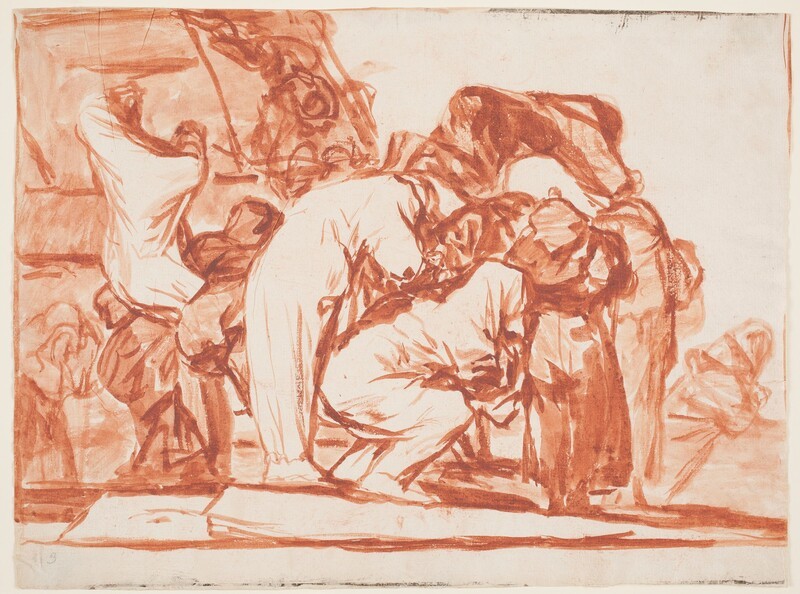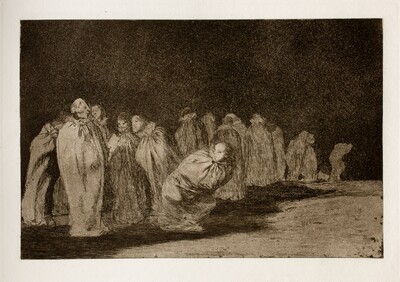- Cronología
- 1815 - 1819
- Ubicación
- The Prado National Museum. Madrid, Madrid, Spain
- Dimensiones
- 243 x 326 mm
- Técnica y soporte
- Reconocimiento de la autoría de Goya
- Documented work
- Titular
- El Prado National Museum
- Ficha: realización/revisión
- 19 Aug 2021 / 13 Apr 2023
- Inventario
- D4284
3 (in composite pencil, lower left)
198 (in pencil, reverse, lower right-hand corner)
8 [label affixed over the inscription "n[o g]rabada"] (handwritten label in black ink, back, upper left)
n [or g]rabada [below sticker] ( in pencil, reverse, top left)
MP Inventory DRAWINGS no. 198 (stamped, reverse, upper right corner)
Watermark: "[MANUEL] SERRA" (right half)
The drawing was inherited in 1828 by Javier Goya, the painter's son, and in 1854 by Mariano Goya y Goicoechea, the artist's grandson. It was subsequently owned by Valentín Carderera (ca. 1861) and Mariano Carderera (ca. 1880). In 1886 it was acquired from Mariano Carderera by the Directorate General of Public Instruction and was assigned to the Prado Museum, where it entered on 12 November 1886.
The Museo del Prado holds nineteen preparatory drawings for the Follies, made in an indeterminate period between 1815 and 1819. José Manuel Matilla states that, of all the preparatory drawings Goya made for his various series of prints, these are the ones that differ most from the final works. In them, Goya basically used red wash as a technique, which he applied over a preliminary drawing in sanguine. The result is sometimes confused and smudged, as he used the brush in an intentionally careless manner. For Matilla, this treatment gives a free and spontaneous character to the scenes, which he even relates to the Black Paintings.
Some of these preparatory drawings were never engraved, or at least there is no direct correspondence with any of the prints in the engraved series of the Disparates. One of them is People in Sacks, a drawing traditionally ascribed to this series of preparatory studies on the basis of its technical and compositional similarity and the similarity of the laid paper with the SERRA watermark. It is an enigmatic scene in which there are at least seven figures, hidden by sacks or shrouds. Their faces and limbs remain hidden inside the fabrics.
On the left side of the composition, one of the figures, dressed in dark clothes, carries another figure in white on his back. The other figures are ambiguous patches of light and shadow. They seem to be moving towards the right, but the purpose of their occupation is very difficult to interpret. It is not clear whether they are a procession of discipliners, clerics in their habits or ghostly beings. Camón Aznar considers it to be a procession of the deceased, dressed in shrouds, but Gassier is unable to give a definite interpretation. One possible origin of the theme could be the popular races of entalegados, celebrated in popular festivities, although it is clear that in Goya's hands the subject takes on an allegorical and terrible dimension. Finally, Matilla relates it thematically to The sacks folly, although it is clear that Goya did not use any of the figures in the drawing in the print. It cannot therefore be said that the drawing was preparatory to the engraving, although it may have been. It would seem to have been reported on the copper and passed through the press, because of the imprint of the imprint of the plate, the numerous folds of the paper on the left side and the black stains that appear on the upper and lower part of the sheet, so it must have been related to an engraving even though it has not been preserved. The relationship with Los ensacados comes from the presence of several figures stuffed in sacks as in the print, although the composition is different, as here the sacks are arranged in a more anarchic manner, mixed with one another and in much less enveloped attitudes.
Sánchez Cantón called this drawing Games of Friars, Camón Aznar called it The Dead folly, while Gassier preferred to call it People in Sacks.
-
Madrid1999
-
GoyaGalleria Nazionale d’Arte Antica di Palazzo BarberiniRoma2000consultant editors Lorenza Mochi Onori and Claudio Strinati. From March 18th to June 18th 2000cat. 40a
-
1860p. 226
-
Madrid1928p.31, cat. 198
-
BarcelonaInstituto Amatller de Arte Hispánico1951pp. 51-52
-
Los dibujos de Goya, 2 vols.MadridAmigos del Museo del Prado1954s. p., cat. 394
-
OxfordBruno Cassirer1964vol. II, p. 410, cat. 269c
-
Vie et ouvre de Francisco de GoyaParísOffice du livre1970p. 327, cat. 1607
-
Dibujos de Goya, 2 volsBarcelonaNoguer1975pp. 462-463, cat. 305
-
Roma Edizioni de Luca2000pp. 126-127, cat. 40

